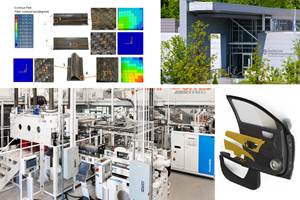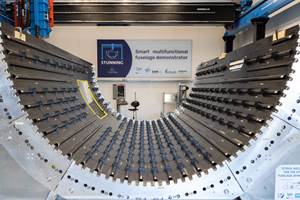Very Light Jets Creating A Demand For Composites
"Baby" jets are causing an aviation buzz but will the market exist?
Tired of long security lines and middle seats on commercial air carriers? An alternative is at hand: entrepreneurial air taxi operators envision a future in which business travelers are rapidly ferried between regional airports in small, fast Very Light Jet (VLJ) aircraft, at prices anywhere from 10 to 50 percent more than today's fully refundable, full-fare commercial ticket, and far lower than existing business or fractional charter costs. The VLJ — the term coined by the aviation industry — is a single-pilot craft similar in size to existing twin-engine, propeller-driven planes, with room for up to eight passengers. With a gross weight of less than 10,000 lb (4,536 kg), they have a range of about 1,000 miles (about 1,600 km) and are able to operate from runways as short as 3,000 ft (914.5m), By comparison, a more traditional mid-sized, eight-passenger business jet, the Bombardier LearJet 60, weighs 23,500 lb (10,659 kg) and requires at least 5,500 ft (1,676m) of runway.
The arrival of VLJs has been made possible, in part, by small, lightweight and energy-efficient turbofan jet engines recently developed by Williams International (Walled Lake, Mich.), Pratt & Whitney Canada (Longueill, Quebec, Canada) and GE Aircraft Engines (GEAE, Cincinnati, Ohio). A surprisingly large number of aircraft manufacturers — each with a unique take on target customers — are beginning to offer VLJs to serve the emerging market.
Established OEMs Cessna (Wichita, Kan.) and Embraer (Sao Jose dos Campos, Brazil) will field aircraft with traditional aluminum-intensive designs, using composites for key secondary structures, while startups Eclipse Aviation (Albuquerque, N.M.) and Avocet Aircraft LLC (Wilton, Conn., in partnership with Israel Aircraft Industries [IAI]) have chosen all-metal designs. Excel-Jet Ltd.'s (Monument, Colo.) new offering combines a composite fuselage with aluminum wings and tail structure. However, Adam Aircraft (Englewood, Colo.), Aviation Technology Group (ATG, Englewood, Colo.), Diamond Aircraft (London, Ontario, Canada and Weiner Neustadt, Austria) and Epic Aircraft (Bend, Ore.) are proceeding with all-composite airframes. Even automaker Honda Motors has built a mostly composite VLJ prototype, the HondaJet, powered by two new Honda-built small turbofan jet engines. (Honda and GE have formed a new company, GE Honda Aero Engines LLC, to produce and sell the new powerplants.) Moreover, GROB Aerospace (Tussenhausen-Mattsies, Germany) is building an all-composite jet that it terms a "light" jet — slightly larger than a VLJ but still smaller than traditional business aircraft (see "Light Jets — Yet Another Category," p. 37).
While manufacturers are buoyant, no VLJ has yet received certification from either the U.S. Federal Aviation Admin. (FAA) or Europe's equivalent, the European Aviation Safety Agency (EASA). Naysayers point out that market demand is unknown at this point, predicting that the risk-averse business aviation industry could be slow to embrace the new models, basically smaller versions of more luxurious business jets. One business aviation analyst opines in an Aviation Week & Space Technology article (July 25, 2005, authored by James Asker) that few commercial airline customers will want to move upward to the higher costs of VLJ air taxis, while moneyed charter habitués will snub the smaller aircraft. Unanswered questions include how to insert private VLJs into already-crowded general aviation airspace near prime airports; how VLJs will be affected by local noise and traffic restrictions; how difficult it will be for pilots and air taxi operators to obtain insurance; and how to address the training gap for general aviation pilots who are used to slower propeller craft. Nevertheless, VLJ manufacturers are opti-mistic that the planes will prove to be an economical aviation boon for air taxis and that private pilots will be willing to trade their props to save travel time.
All-composite for on-demand operation
Adam Aircraft entered the VLJ market in late 2002 with the A700, a jet-powered derivative of its existing FAA-certified A500 twin-engine, turbocharged piston aircraft, an all-carbon composite design. The A700 has a larger cabin, longer overall length and is "beefier" to handle higher aerodynamic and crash loads created by higher cruise speed and altitude, says Pierre Harter, Adam's director of advanced structure. The high degree of commonality between the two planes is expected to make the A700's FAA type certification an easier process than for new jet manufacturers, because more than half the parts have already been certified for the A500. (A500 certification came in May 11, 2005.)
According to Harter, the A700 is made in a similar fashion as the A500 (see HPC July 2002, p. 33) using AGATE (Advanced General Aviation Technology Experiments) carbon fiber/epoxy Torayca prepregs manufactured by Toray Composites America Inc. (Tacoma, Wash.). As explained in previous HPC articles (for example, see "AGATE Methodology Proves Its Worth," HPC May 2003, p. 38), Toray has prequalified three prepreg systems, meaning that only limited additional qualification testing is needed on the part of a manufacturer to meet FAA requirements, thus saving considerable program time and cost.
Wings, tail and booms for the A700 are exactly the same shape as the A500 and are made on the same composite tools. Wing spars and skins for the jet are thicker and require more material. Wing skin layups start with a thin, solid laminate at the tip, and increase in thickness and complexity toward the root with the addition of core, typically aramid honeycomb supplied by Euro-Composites Corp. (Elkwood, Va.). Ply layup varies from 3/core/3 to 6/core/6, and is typically balanced and symmetrical with the majority of fibers oriented 0°/90° or ±45°, says Harter. The jet's wing skins incorporate a higher-density core, compared to the A500, to handle higher gust loads. As with the A500, parts are cured in a 50-ft (15.2m) long oven built by Gehnrich Oven Sales Co. (Ronkonkoma, N.Y.).
Because the A700's lightweight Williams FJ-33 jet engines each weigh about 300 lb (136 kg) less than a piston engine, the saved weight and center of gravity (CG) shift allows a larger fuselage — about 30 inches (76 cm) longer than the six-seat A500 — to accom- modate either two extra seats or a lavatory, explains Harter. The two engines have a higher fuel burn rate, however, so in addition to fuel tanks in the wings, a 135-gal capacity fuel pod has been added to the plane's belly. Robust composite skid plates have also been incorporated on the craft's underside. "In a crash scenario," Harter says, "the fuel has to remain contained, so the structure has been sized to meet those higher loads." The A700's weight figures aren't yet available from the company but, for comparison, the A500 has a gross weight (with fuel and passengers) of 7,000 lb (3,175 kg).
At $2.25 million (USD), the A700 has a 41,000 ft ceiling, 340-knot (391-mph) cruise speed and an 1,100-mile (1,770 km) maximum cruise range. Adam is squarely targeting the air taxi market and believes it has the "biggest potential" for VLJs, says Harter. A major air taxi operator has already preordered 75 A700s for its operation, although deliveries are dependent on certification, anticipated for late 2006.
A hybrid for private pilots
Excel-Jet developer Robert Bornhofen has taken a different approach with his VLJ entry, the Sport-Jet. "Our customer is the pilot and the plane is designed for his or her comfort. We're not interested in air taxi," he explains. "Our focus is the general aviation pilot market." Working without outside investors and believing firmly that obtaining insurance will be the highest hurdle faced by VLJ buyers, Bornhofen's team has designed a hybrid aircraft that combines an aluminum tail and wings with a composite fuselage, a design he feels will maximize FAA's comfort level and thus expedite certification and insurability of the plane.
The four-place jet has only one engine, a Williams FJ-33, and is priced at $1.1 million. With a lower operational ceiling of 25,000 ft, Sport-Jet's maximum takeoff weight is a mere 4,900 lb (1,770 kg). But specs are otherwise fairly comparable to other VLJs — cruise speed is 350 knots/400 mph, range is about 1,000 miles (1,600 km) and only 2,300 ft (701m) of runway is required for takeoff. The single engine and lower ceiling were intentional choices, explains Bornhofen: "Certification and opera-tional rules get more complex above 25,000 ft and with multiple engines. The insurance issues really drive this industry."
The Sport-Jet, with a distinctive low-to-the-ground stance, was developed based on Bornhofen's prior experience designing a twin-engine aircraft with "superb" flight handling characteristics. Bornhofen says his market research indicated customers wanted a wider cabin, so the Sport-Jet's cabin width is the same as a Lear 35 jet and 14 inches (35.6 cm) wider than a Raytheon Beech Bonanza, a common twin-engine turboprop. The initial master model was produced traditionally by hand-shaping plywood frames and placing them in series to create the fuselage shape, from which carbon-fiber prepreg tools were fabricated. The prototype was made by Lancair (Redmond, Ore.).
The fuselage is an interesting combination of solid and cored laminate. Five solid laminate "rings," approximately 3 inches (75 mm) wide and 0.38 inch (9.5 mm) thick, are the principal load-bearing structures. The rings are joined together with three solid-laminate longerons of similar width and thickness, oriented parallel to the fuselage's long axis. The combination of the rings and longerons forms a sort of structural roll cage. Bornhofen explains that the ring and longeron plies are interwoven during layup to create a single, integrated, rigid part. Torayca AGATE prepregs were used on the prototype, but FiberCote's (Waterbury, Conn.) AGATE materials will be qualified as a backup for production, says Bornhofen.
The structural cage becomes a fuselage with the addition of the skin, typically a balanced layup of 3/core/3, produced in four open female molds with a combination of carbon and fiberglass. Skin parts are bonded to the cured fuselage cage. The elongated composite nose cone is produced separately and adhesively bonded with epoxy to the main fuselage. An aluminum tail cone surrounds the jet engine.
An aluminum spar/wing box structure, to which the removeable wings are bolted, carries the wing loads and is mated to the fuselage structure in a proprietary manner that avoids galvanic reaction. Bornhofen claims there is no weight penalty caused by use of aluminum for the wings and high T-tail, because aluminum delivers a stiffer part for the design weight. He prefers metal for those parts, citing better performance during lightning strike. In the case of damage, an off-the-shelf aluminum replacement wing or tail installs easily, a scenario with appeal to insurers. Control flaps and ailerons, which in the prototype are composite with a core of Rohacell foam (Degussa Rohm GmbH & Co. KG, Darmstadt, Germany), will likely remain composite in production.
While no advance sales have been made, the prototype is nearly ready for flight tests. FAA certification is at least 18 months down the road, says Bornhofen, and no firm decision on a fabricator has been made. "Piston aircraft are getting more expensive to buy and maintain every year while small jet engines are becoming more efficient," he concludes. "The cost/benefit is starting to look pretty good for small jets."
Civil and military customers
Aviation Technology Group's high-performance Javelin jet resembles a mini-F-22 Raptor for a reason — in addition to general aviation customers, the company is targeting the military trainer market, says company founder and chairman George Bye. The Javelin completed its maiden flight on Sept. 30, 2005, and aerodynamic flight testing is currently underway. Order deposits to date total 106.
The sleek design has the smallest cabin dimensions of any VLJ, with tandem seating for two — one passenger sits behind the pilot. Wingspan is 23 ft/7m, length is 36 ft/11m, and baggage payload is about 200 lb (90.7 kg). Service ceiling is 45,000 ft. Weighing about 6,200 lb (2,812 kg), and powered by two Williams FJ-33 turbofans, the Javelin will cruise at 520 knots (600 mph). "It will be the fastest general aviation certified plane in the world," Bye claims.
The plane's all-composite airframe was designed with CATIA 5 from Dassault Systemes (Paris, France), coupled with MSC.Nastran and MSC.Patran finite element modeling software from MSC.Software (Palo Alto, Calif.). The prototype was fabricated by Composite Solutions (Scapoose, Ore.), using Toray's Torayca T700G 12K unidirectional carbon/epoxy tape and T700S 12K noncrimp, plain-weave fabric for the fuselage, wing and empennage structures. ATG's chief structural engineer Dick Ulman says that several prepreg systems are under consideration for actual production aircraft: "We're looking at a number of different materials. The Torayca material is a strong contender." While some form of automated fabrication may be used — tape placement is a possibility — once full production is underway, Ulman says that, for now, parts are being hand layed up, in both open female and male molds, and cured in an autoclave.
The airframe includes a combination of solid laminate and cored sandwich construction. The short, raked wings have a three-spar design, with the forward spar close to the leading edge, a second in the middle and the third supporting the aft wing. Unidirectional carbon tape is layed longitudinally along the spar axis to form the spar caps, and biaxial ±45° woven material forms the spar webs. The prototype has a two-part fuselage, with a top half and a bottom half, but Ulman says the production version might be made differently, with cylindrical segments.
Part count reduction is a big program driver, and labor-saving ideas are being considered, such as integral sub-assemblies or modules. Complex tools with removable aluminum mandrels are under development says Ulman, to enable assembly of the ribs, stringers and skins for "one-shot" autoclave cure. The integral design eliminates secondary bonding and metal fasteners, says structures engineer Bruce Gillit. "A high-integrity bonded joint is a much better solution, in our opinion, and produces greater structural integrity."
Both Nomex honeycomb and Degussa Rohm's Rohacell polymethacrylimide (PMI) foam are being investigated for sandwich structure in the fuselage and for control surfaces, but Ulman says trade studies are still ongoing and a final material decision hasn't been made. Other "interesting" challenges include the two air inlet ducts for the jet engines, which have compound curvature and can't be produced in one piece because of assembly issues. Another is the heat produced by the engines in the tail area. A high-temperature solution like bismaleimide (BMI) resin isn't feasible because of cost, says Ullman, so some sort of insulating blanket or heat shielding material will be needed in the engine compartments and around the engine exhausts to protect the composite structure.
The military trainer version of the Javelin was exhibited at this year's Paris Air Show, and it received a "warm reception," says Bye. ATG has partnered with Israel Aircraft Industries (IAI) to produce the Javelin Mk20 AJT military trainer version, which comes equipped with ejection seats, much more complex avionics and radar, and other upgrades. The company predicts that future military demand could lead to a wide variety of applications, like homeland defense surveillance, for example.
Price for a civilian Javelin is about $2.8 million, and will run about $5.5 million for the trainer version. Bye thinks the air taxi market will grow slowly, because of airspace and traffic integration issues. But, he's banking on the tens of thousands of general aviation pilots or business jet owners who want to move up to a high-performance plane. "The civilian Javelin is about the same size and same price as a medium-twin turbo aircraft and has a ton more performance — there's no comparison," he concludes.
Unusual one-off a production "maybe"
Honda R&D Americas Inc. (Raymond, Ohio) took the somewhat radical step in the mid-1990s of building a twin-engine jet aircraft around a new Honda turbofan jet engine, the Honda HF118. The engine, developed by Honda Aero Inc. (Reston, Va.), a subsidiary of Honda Motor Co. (Tokyo, Japan), is so promising that GE Aircraft Engines has formed a partnership with Honda to commercialize it. Yet, speculation now turns on whether Honda will pursue development of the aircraft itself, which was first flown in December 2003.
The HondaJet, with composite fuselage and metal wings and tail, caused significant buzz when it made its first public appearance at this year's Experiment Aircraft Assn. (EAA) AirVenture 2005 air show in Oshkosh, Wis. Its unusual over-the-wing engine-mount configuration sets it apart from other VLJs. HondaJet's designer, vice president of Honda R&D Americas Michimasa Fujino, spent considerable time analyzing the pros and cons of an aluminum vs. a composite wing: "From a structural design viewpoint, the bearing stress and interlaminar shear of composite materials are lower than aluminum. In our case, we had several fittings and brackets attached to the wing structure [for engine mounts] that required web or rib thickness to be increased to reduce the stress. In the end, using composites for VLJ wing structure is not a big advantage."
Lightning strike protection also was simpler with aluminum. A metallic mesh embedded in a composite causes slight surface roughness, which requires fairing and finishing work, Fujino contends, so machined aluminum was ultimately chosen.
Honda built the prototype in-house during the mid-1990s. Both metal (Nobinite, similar to Invar) and composite tools, some fabricated in-house, others made by subcontractors, were used for layup. The main fuselage was molded in left and right halves from solid laminates built up with 177°C/350°F cure carbon/epoxy prepreg from Cytec Engineered Materials (Tempe, Ariz.), made with Toho Tenax Co. Ltd. (Tokyo, Japan) G30-500 intermediate-modulus fiber and 5276-1 toughened epoxy. The fuselage skin was stiffened with stringers and frames, which were made separately on a flat table, then cut to shape with an automated cutting machine. After heating to 90°C/194°F, the cut shapes were press formed in a mold, but not allowed to fully cure. The shaped frames and stringers were then demolded and placed on the skin layups, and cocured with the skins in an autoclave, to form an integrated structure. Each frame and stringer was designed with the same dimension and shape, says Fujino, so that only two molds were required. Skin layup was balanced but varied throughout the fuselage to optimize resistance to imposed loads (exact fiber architecture is proprietary). The two halves were adhesively bonded, but metal fasteners were used to ensure a secure bond.
The cockpit and the tapered tail section were cored with aramid honeycomb, using the same carbon/ epoxy prepreg for the skins, to achieve compound curves. To avoid core crush during autoclave cure (at 85 psi/5.86 bar), the core was beveled along the part edges and a "picture-frame stabilizing method" was employed — adding a tie-down ply between the skin and the core to prevent core shift. "Our nose design has 10 percent less drag compared to turbulent-flow nose fuselage designs," notes Fujino.
A wing-to-body fairing also is carbon composite. Up to five passengers can be carried at a cruise speed of 400 knots/460 mph, with room left over for a lavatory. Ceiling is 41,000 ft, and range is 1,100 nm/1,265 miles (2,100 km). The over-the-wing engines maximize cabin space, says Fujino, since the contour doesn't have to pinch down to accommodate engine mounts.
Fujino says that "at this moment" there is no formal business plan for production. Nevertheless, this VLJ has good performance figures and interest is high.
Related Content
Clemson Composites Center: Working with industry to transform composites
Offering liquid and thermoplastic composites molding, LCA-weighted simulation, full testing to validate materials/process data cards, CCC’s digital life cycle approach unites manufacturing, microstructure, part property map and structural analysis.
Read MoreThermoplastic composites welding: Process control, certification, crack arresters and surface prep
More widespread use of welded composite structures within a decade? Yes, but further developments are needed.
Read MoreSuCoHS project: Advancing composite solutions for parts with high thermal and mechanical loads
New materials, structural concepts and manufacturing using sensors for composites that resist fire, temperature and loads while providing weight and cost savings versus metals.
Read MorePlant tour: National Institute for Aviation Research, Wichita, Kan., U.S.
NIAR, located at Wichita State University in the heart of the American aerospace manufacturing industry, has evolved to become a premier hub of teaching, R&D, creativity and innovation.
Read MoreRead Next
From the CW Archives: The tale of the thermoplastic cryotank
In 2006, guest columnist Bob Hartunian related the story of his efforts two decades prior, while at McDonnell Douglas, to develop a thermoplastic composite crytank for hydrogen storage. He learned a lot of lessons.
Read MoreComposites end markets: Energy (2024)
Composites are used widely in oil/gas, wind and other renewable energy applications. Despite market challenges, growth potential and innovation for composites continue.
Read MoreCW’s 2024 Top Shops survey offers new approach to benchmarking
Respondents that complete the survey by April 30, 2024, have the chance to be recognized as an honoree.
Read More

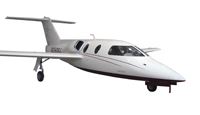
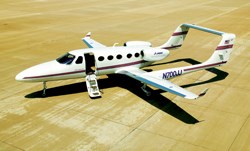
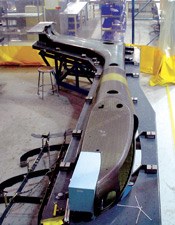

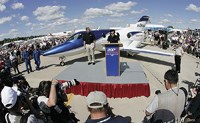


















.jpg;maxWidth=300;quality=90)

